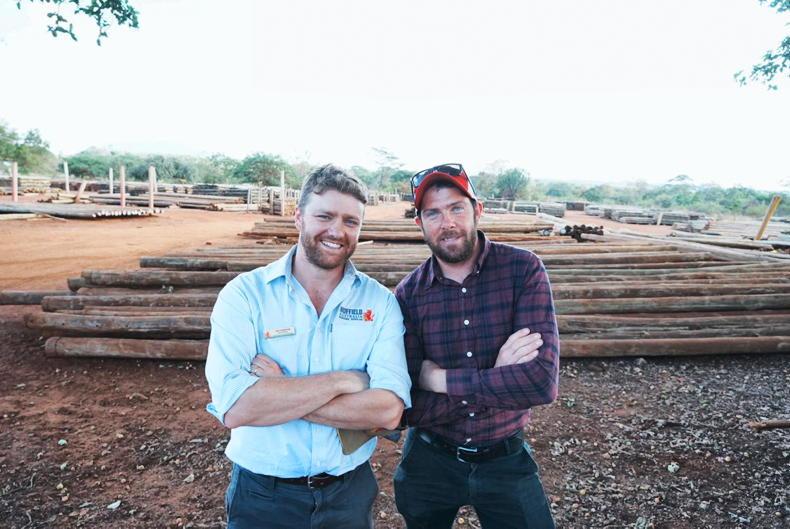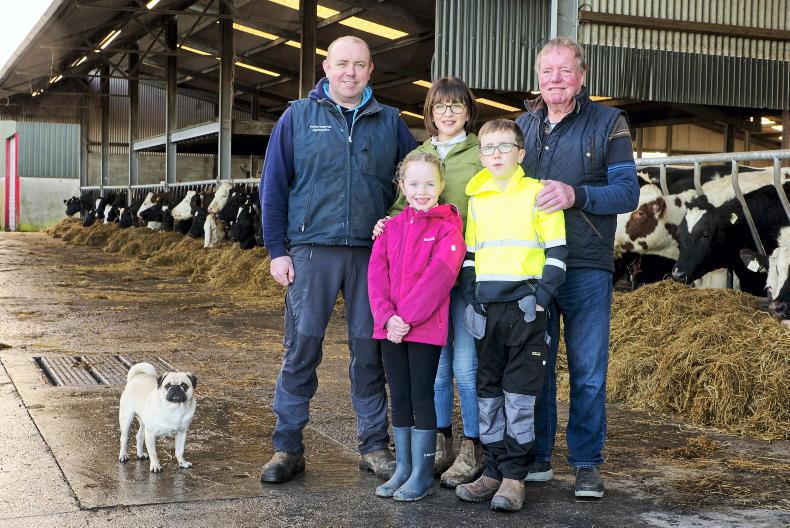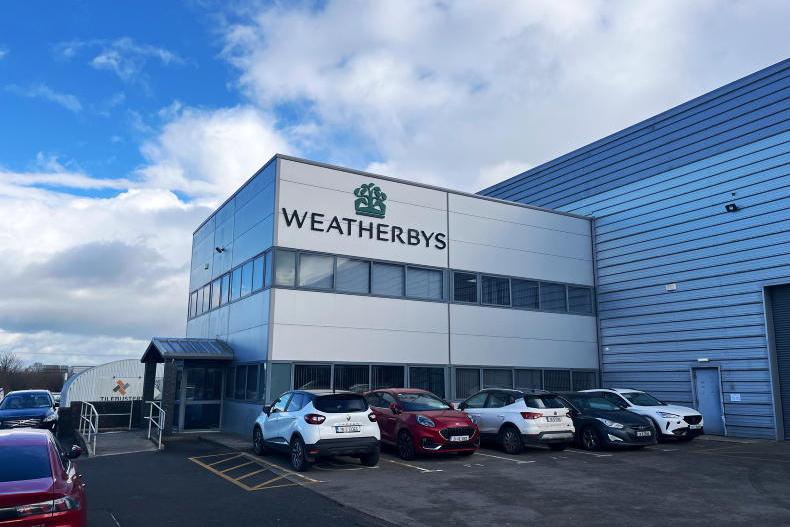Even though the 5,000 or so heifers on the Sexing Technologies farm in central Ohio produce milk, the real output from the farm is data and a high-speed genetic progress programme.
Sexing Technologies (ST) is better known for developing the technology for sexed semen, but it has also grown into a large AI company with a global footprint and is headquartered in the US.
The data it collects on the Ohio heifer farm is used to develop new indices on feed efficiency and methane emissions and this, in turn, is used to identify elite genetics with these important traits.

New feed weighing boxes have been installed in one of the heifer barns.
The objective is to produce high genetic merit bulls for the AI company and position itself as a market leader in genetics by adopting the latest science borrowed from human reproduction.
Reducing the generational interval is one of the key parts of its strategy.
Speeding up generational interval means that higher genetic merit bulls hit the market earlier than they normally would under a traditional breeding programme.

Green-feed machines measure methane emissions from cows and heifers.
Currently, dairy AI bulls in Ireland are bred using the traditional method: a cow is mated with a bull, the calf is born and if it’s a bull and good enough to enter an AI stud, semen will be harvested from the bull when it’s 12 months of age. Because younger animals have the highest genetic merit, the younger the sire and the dam are, the better the bull should be.
Of course, this type of a policy is only possible with genomics because the reliability of a bull is greatly enhanced by having the genotype.
So calling this a traditional approach is a little bit false because, traditionally, bulls were selected based on parental average, so the more progeny data available on a bull, the greater the reliability. Genomics has fast-tracked all that and now young animals with no daughters on the ground are reliably considered the best genetics.

There are over 5,000 animals on the farm located in central Ohio, United States.
So, what is ST doing differently? Instead of waiting for a heifer to calve at 20 to 24 months, it is instead collecting oocytes or eggs from high genetic merit heifers at just five to eight months of age.
These eggs are then fertilised with sexed sorted semen in a lab through IVF. This semen is from high genetic merit young bulls and the embryo is then put into recipient cows, both on the Ohio farm and on other commercial farms that ST has arrangements with.
According to Paul Detwiler, the general manager of the Ohio heifer farm, ST only takes back the cream of the calf crop, as determined by their genotype.
The best bull calves will end up going to their AI stud farms for further rearing and assessment while the heifer calves are kept at the Ohio farm.
Heifers
In Ireland and most other places, AI companies aren’t really interested in heifers but this is not the case with ST.
The Ohio heifer farm is home to 5,000 females, the majority of which are heifers along with 900 dairy cows, 70% of which are first lactation. The thinking here is that in order to maximise genetic gain, both the dam and the sire needs to be the highest genetic merit available.

Cows are milked in groups of 200 with four robots per group.
Using IVF and embryo transfer multiple matings can take place simultaneously from the eggs of one heifer.
By assembling all of these high genetic females, ST has full control over the collection of eggs and the IVF process all in the one farm. On top of this, it is able to collect data on the animals on the ground to help further genetic gain in important but hard-to-measure traits such as feed efficiency and methane emissions.
The scale of the operation is massive with rows upon rows of barns more or less covering the 200 acres of land owned by ST.
With 80 full-time employees and 20 part-time, as well as the highest spec of instrumentation for measuring feed intake and methane emissions, the farm would beat the dairy research facilities of any university or publicly funded institution anywhere in the world.
The cows are milked in 16 Lely robots and all the feed used on the farm is mixed in one central kitchen before being fed out. All of the feed used on the farm is grown by local farmers.
Animals on the farm have been measured for feed efficiency since 2012. This is achieved through hundreds of individual feed bins where the amount of feed eaten by each animal is weighed.
Paul says that they are looking to identify heifers with a reduced level of feed intake but that still produce well, as these heifers are more efficient with their feed.
When it comes to methane, the farm has its own Greenfeed methane measuring devices situated in the heifer and milking cow barns.
These measure methane emissions from each animal and the results of this and the feed efficiency work is incorporated into the ST Eco$ index.

All the feed is mixed in one central kitchen and then carted to the cow and heifer barns. There are nine different rations made daily.
This index is made up of 49% milk production traits, 28% feed efficiency and methane traits and 23% made up of form and function traits such as fertility, feet and legs and type.
Importantly, the data used to generate this index is the intellectual property of ST and the Eco$ index runs alongside the industry standard Net Merit index. It’s a bit like an Irish AI company bringing out its own index to rival the EBI.
There are between 1,500 and 2,000 oocytes flushed from heifers each week and these are processed using IVF in the in-house labs in Ohio to create around 500 embryos of both male and female sex each week.
The males are then put into recipient cows and heifers in the Ohio farm, while the female embryos are usually put into recipient cows on their partner farms.
There are about 250 calves born on the farm each month and Paul says that 95% of these are from embryo transfer. So, if they have a really exciting heifer, she will be flushed and her eggs mated with different bulls in the lab and the embryo put into other cows.
Some of these will produce bull calves that could go to stud and more will produce heifer calves, while they themselves will be flushed for eggs at seven months of age.
The level of investment by a private company in the research facilities at ST Ohio is just jaw-dropping. The beneficiaries of this investment will be ST, which will get more market share by breeding better bulls, but also the farmers that use those bulls.
Effectively, it’s increasing the competitiveness of confinement-based farms through faster genetic gain.
If you look at what is happening in Ireland today, the breeding programme is a bit like casting a big net using genomics with AI companies picking up the bull calves that stand out. OK, there is some planned mating going on but it’s not near as strategic as what ST is doing and nor is it speeding up generational intervals.
With more and more sexed semen and beef bull usage, the current approach in Ireland is going to come under pressure as there are going to be fewer male dairy calves born, so the pond AI companies’ fish in is getting smaller.
Should the Irish industry be coming together now to establish an elite heifer breeding programme in order to fast track genetic gain in dairy bulls?
The AI companies decided not to collaborate on sexed semen labs. If they do their own thing on developing nucleus herds, we will have more duplication, more costs and poorer outcomes.
Feed efficiency and methane work is slow and costly – that’s why it’s not yet being done here at scale. ST is doing it because it thinks it’s important.
If grass-based systems are to remain competitive in the long term, we need to utilise the resources available to maximise genetic gain.
Even though the 5,000 or so heifers on the Sexing Technologies farm in central Ohio produce milk, the real output from the farm is data and a high-speed genetic progress programme.
Sexing Technologies (ST) is better known for developing the technology for sexed semen, but it has also grown into a large AI company with a global footprint and is headquartered in the US.
The data it collects on the Ohio heifer farm is used to develop new indices on feed efficiency and methane emissions and this, in turn, is used to identify elite genetics with these important traits.

New feed weighing boxes have been installed in one of the heifer barns.
The objective is to produce high genetic merit bulls for the AI company and position itself as a market leader in genetics by adopting the latest science borrowed from human reproduction.
Reducing the generational interval is one of the key parts of its strategy.
Speeding up generational interval means that higher genetic merit bulls hit the market earlier than they normally would under a traditional breeding programme.

Green-feed machines measure methane emissions from cows and heifers.
Currently, dairy AI bulls in Ireland are bred using the traditional method: a cow is mated with a bull, the calf is born and if it’s a bull and good enough to enter an AI stud, semen will be harvested from the bull when it’s 12 months of age. Because younger animals have the highest genetic merit, the younger the sire and the dam are, the better the bull should be.
Of course, this type of a policy is only possible with genomics because the reliability of a bull is greatly enhanced by having the genotype.
So calling this a traditional approach is a little bit false because, traditionally, bulls were selected based on parental average, so the more progeny data available on a bull, the greater the reliability. Genomics has fast-tracked all that and now young animals with no daughters on the ground are reliably considered the best genetics.

There are over 5,000 animals on the farm located in central Ohio, United States.
So, what is ST doing differently? Instead of waiting for a heifer to calve at 20 to 24 months, it is instead collecting oocytes or eggs from high genetic merit heifers at just five to eight months of age.
These eggs are then fertilised with sexed sorted semen in a lab through IVF. This semen is from high genetic merit young bulls and the embryo is then put into recipient cows, both on the Ohio farm and on other commercial farms that ST has arrangements with.
According to Paul Detwiler, the general manager of the Ohio heifer farm, ST only takes back the cream of the calf crop, as determined by their genotype.
The best bull calves will end up going to their AI stud farms for further rearing and assessment while the heifer calves are kept at the Ohio farm.
Heifers
In Ireland and most other places, AI companies aren’t really interested in heifers but this is not the case with ST.
The Ohio heifer farm is home to 5,000 females, the majority of which are heifers along with 900 dairy cows, 70% of which are first lactation. The thinking here is that in order to maximise genetic gain, both the dam and the sire needs to be the highest genetic merit available.

Cows are milked in groups of 200 with four robots per group.
Using IVF and embryo transfer multiple matings can take place simultaneously from the eggs of one heifer.
By assembling all of these high genetic females, ST has full control over the collection of eggs and the IVF process all in the one farm. On top of this, it is able to collect data on the animals on the ground to help further genetic gain in important but hard-to-measure traits such as feed efficiency and methane emissions.
The scale of the operation is massive with rows upon rows of barns more or less covering the 200 acres of land owned by ST.
With 80 full-time employees and 20 part-time, as well as the highest spec of instrumentation for measuring feed intake and methane emissions, the farm would beat the dairy research facilities of any university or publicly funded institution anywhere in the world.
The cows are milked in 16 Lely robots and all the feed used on the farm is mixed in one central kitchen before being fed out. All of the feed used on the farm is grown by local farmers.
Animals on the farm have been measured for feed efficiency since 2012. This is achieved through hundreds of individual feed bins where the amount of feed eaten by each animal is weighed.
Paul says that they are looking to identify heifers with a reduced level of feed intake but that still produce well, as these heifers are more efficient with their feed.
When it comes to methane, the farm has its own Greenfeed methane measuring devices situated in the heifer and milking cow barns.
These measure methane emissions from each animal and the results of this and the feed efficiency work is incorporated into the ST Eco$ index.

All the feed is mixed in one central kitchen and then carted to the cow and heifer barns. There are nine different rations made daily.
This index is made up of 49% milk production traits, 28% feed efficiency and methane traits and 23% made up of form and function traits such as fertility, feet and legs and type.
Importantly, the data used to generate this index is the intellectual property of ST and the Eco$ index runs alongside the industry standard Net Merit index. It’s a bit like an Irish AI company bringing out its own index to rival the EBI.
There are between 1,500 and 2,000 oocytes flushed from heifers each week and these are processed using IVF in the in-house labs in Ohio to create around 500 embryos of both male and female sex each week.
The males are then put into recipient cows and heifers in the Ohio farm, while the female embryos are usually put into recipient cows on their partner farms.
There are about 250 calves born on the farm each month and Paul says that 95% of these are from embryo transfer. So, if they have a really exciting heifer, she will be flushed and her eggs mated with different bulls in the lab and the embryo put into other cows.
Some of these will produce bull calves that could go to stud and more will produce heifer calves, while they themselves will be flushed for eggs at seven months of age.
The level of investment by a private company in the research facilities at ST Ohio is just jaw-dropping. The beneficiaries of this investment will be ST, which will get more market share by breeding better bulls, but also the farmers that use those bulls.
Effectively, it’s increasing the competitiveness of confinement-based farms through faster genetic gain.
If you look at what is happening in Ireland today, the breeding programme is a bit like casting a big net using genomics with AI companies picking up the bull calves that stand out. OK, there is some planned mating going on but it’s not near as strategic as what ST is doing and nor is it speeding up generational intervals.
With more and more sexed semen and beef bull usage, the current approach in Ireland is going to come under pressure as there are going to be fewer male dairy calves born, so the pond AI companies’ fish in is getting smaller.
Should the Irish industry be coming together now to establish an elite heifer breeding programme in order to fast track genetic gain in dairy bulls?
The AI companies decided not to collaborate on sexed semen labs. If they do their own thing on developing nucleus herds, we will have more duplication, more costs and poorer outcomes.
Feed efficiency and methane work is slow and costly – that’s why it’s not yet being done here at scale. ST is doing it because it thinks it’s important.
If grass-based systems are to remain competitive in the long term, we need to utilise the resources available to maximise genetic gain.















SHARING OPTIONS